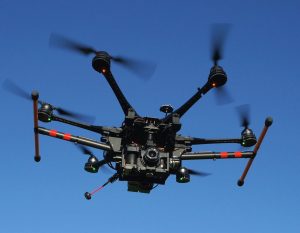The Chula Vista Police Department has been given the green light — a Certificate of Authorization — by the Federal Aviation Administration to fly drones beyond their direct visual line of sight.
As of March 12, drones flown by the department will no longer require a pilot to maintain a direct visual line of sight — an FAA regulation — allowing them to potentially expand their range from one nautical mile to three.

The provision authorizes the CVPD to take the next step with its Unmanned Aircraft Systems Integrated Pilot program, thought into existence in 2015 and which has been active since 2017.
Chula Vista is partnered with the city of San Diego in the program – a 10-strong-group creation by the FAA put in place to allow public and private companies and organizations around the United States to test out, improve and help shape future regulations for UAS.
In total the CVPD has used drones on 374 calls for service – contributing to 54 arrests – according to data compiled on the city’s official government website.
The drones are not used to randomly surveil or patrol, but instead are used to respond to emergency calls for service, ones that are life threatening or crimes in progress.
Kevin Pointer, Chula Vista’s senior economic development specialist, said while other police departments use drone’s to assist with operations, the CVPD is unique in the way it initially deploys them.
“We are utilizing the drones as the first responders, the first one on scene, so that drone is responding to a call for service,” he said. “Either a 911 call, or a police officer on patrol noticing a crime in progress and then initiating that call for service directly.”
The ability to now fly cop-drones beyond their direct visual line of sight further puts the CVPD into a class of its own, as they are the first and only police department in the country allowed to do so in an urban city environment.
Currently, the CVPD would fly drones with a pilot in a control room and an officer on the roof, who could keep a direct visual line of sight on the drone and its airspace, and have the ability to take-over if necessary.
That can now change, according to Pointer.
“Because the FAA has approved our officers now flying beyond the visual line of sight, that implies that there’s no longer a secondary officer or officers needed up on the roof,” he said.
The increased distance allowance came to fruition following months of collaboration with the FAA on the topic.
Bill Valle, Chula Vista’s director of engineering & capital projects/city engineer, said in an interview with The Star-News in early March that not having the ability to fly drone’s beyond their direct visual line of sight was impeding progress.
“If you have to do line of sight you’re not going to be able to deploy drones from here in western Chula Vista and go to the eastern side of the city,” Valle said. “That’s where that line of sight rule is kind of problematic.”
Despite being given the OK to fly out-of-sight missions, the department plans on holding off until they can ensure complete safety, according to CVPD Captain Vern Sallee, the senior manager in charge of the program.
“Even though we have authorization we want to make sure that we plan it properly and have all the safety measures in place to ensure that we have obviously full control over the drone in the airspace to avert any issues,” he said.
The drones fly under 400 feet in the air, making them more-or-less free and clear from potential airborne obstacles, but the possibility of other drones or a helicopter entering the airspace still looms.
“The safety is an absolute top priority of the program on virtually every single flight,” Sallee said. “Every single flight has a checkout procedure, a startup procedure, making sure that the air space that we’re going into is clear of obstacles during the entire flight so safety is paramount, and if it’s not safe we don’t fly.”
Residents seeking more information about CVPD’s UAS program can visit the police department section of www.chulavistaca.gov, following the link marked “Drone Program.”

